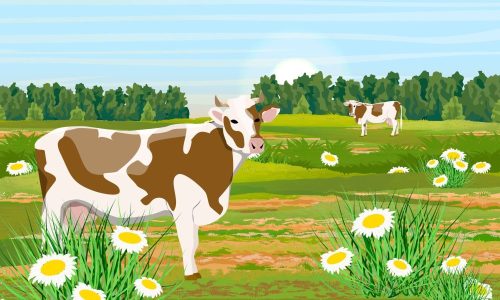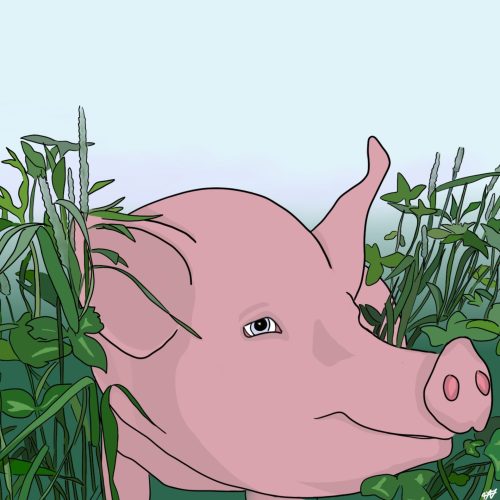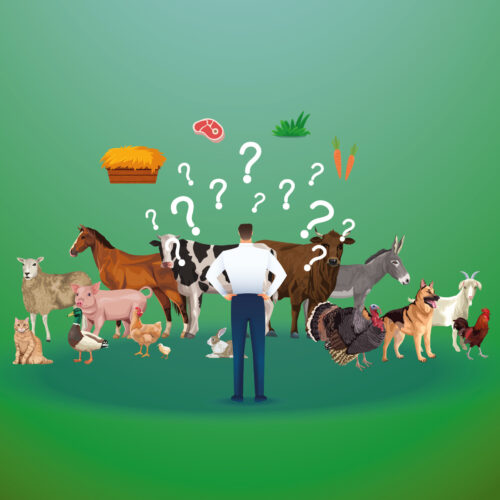

FALSE
Scientific publications do not show a direct link between animal welfare and the size of a farm… and explain that other factors must be taken into account!
KEEP IN MIND
- Farm size has increased significantly in recent years. However, French farms are still of modest sizes compared to many other countries
- Scientific publications do not show a direct link between animal welfare and the size of a farm
- Larger farms potentially present more risks for animal welfare, but also certain advantages in terms of better management (greater investment, etc.). Access to the outdoors is the most problematic issue
- Animal welfare depends mainly on farm management, which is specific to each farm regardless of its size
For many consumers, an increase in farm size is often associated with animal welfare deterioration. However, scientific publications do not show a direct link between animal welfare and the size of the farm, neither in one direction nor the other… and explain that other factors must be taken into account!
⚠️ Warning: a few precautions
- The presented results are based solely on farm size. Other factors, such as farming types or intensification levels were ignored. Most examples are taken from publications on dairy farms – which are the most common types – but can be transposed to other farms.
- The mentioned scientific studies researched the effects of farm size on animal welfare… but of course they do not cover every situation. Moreover, in some studies one particular farm size is regarded as large while others would consider it small… the important thing is to compare farms of different sizes in the same study. The elements presented here, like all scientific results, should be considered with caution.
Large-scale or small-scale farms: what exactly are we talking about?
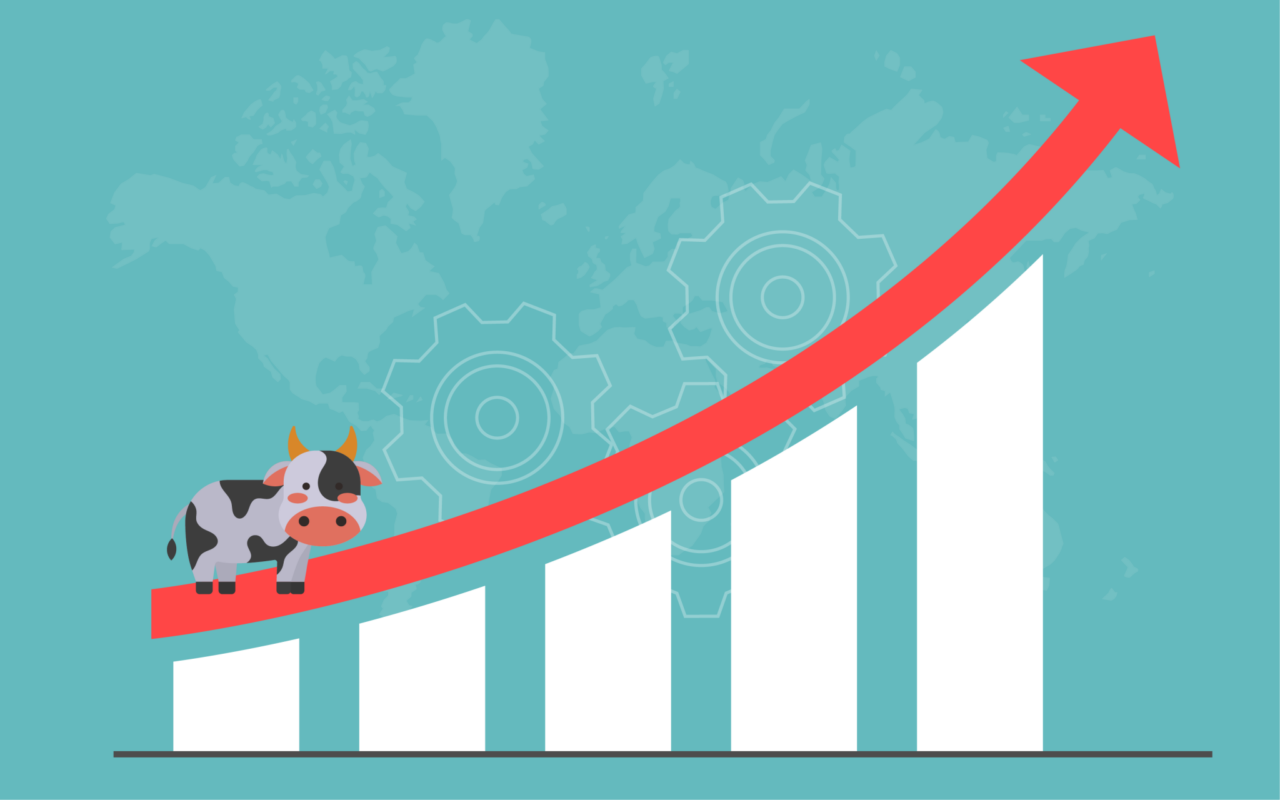
Historically, farms were small, with only a few animals managed by a family. This type of farming is still present in many areas of the world, especially in African countries.
However, since the end of World War II, agriculture in many countries has changed. The number of farms has decreased… but as the demand for food has continued to grow, the size of farms has increased. This increase was the result of a political will to increase productivity and decrease production costs, and was made possible by developments in agricultural mechanization and veterinary medicine.
Examples of growth:
🇳🇱 In the Netherlands, the average size of a dairy or poultry farm doubled between 1995 and 2008, while the average size of a pig farm tripled[1].
🇺🇸 In the United States, the average number of dairy cows per farm increased from 50 to 144 between 1987 and 2012. More importantly, in 2012, more than 50% of farms had more than 900 dairy cows.
🇫🇷 In France, the average number of dairy cows per farm has increased from 17 in 1983 to 46 in 2020[2].
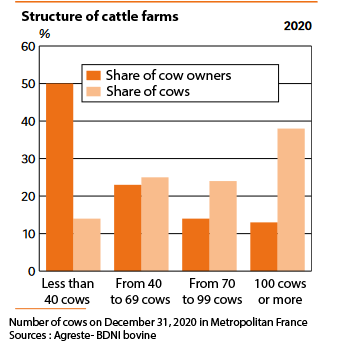
🔎 Understanding the graph: In France in 2020, 50% of all farms had less than 40 cows (which corresponds to about 15% of all cows) and 15% of all farms had more than 100 cows (which corresponds to almost 40% of all cows).
🐄 An EFSA report (2015) considered a dairy farm to be small if the total number of mature cows was less than 75 and more than 80% of workforce was family[3].
🐖 In pig production, between 2000 and 2018, the average size of sow farms increased in France from 140 to 226 sows (+60%) and in Denmark from 170 to 769 sows (+350%). In Spain in 2018, there were on average 1 158 sows per farm[4][5].
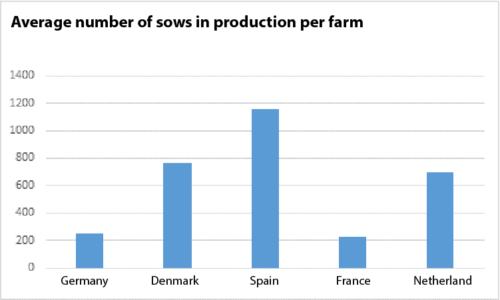
There are even farms with more than 10,000 sows in North America and the construction of a new farm in China planned to house over 80,000 sows[6].
Concerning poultry, in 2016, 9% of farms in France had more than 50,000 broilers and 12% of farms more than 50,000 laying hens[7]. In Australia, farm size varies from 1,000 to 500,000 hens[8].

In short!
We can observe an increase in farm size, but with a great diversity according to species and countries! Very often, when the number of animals becomes important, they are raised in independent units, sometimes in different buildings.
What about welfare?
Perception of the animal
Welfare is individual and specific to each animal. For an animal, what is important is to be able to express its behavior, to have enough to eat and a satisfactory level of comfort… not the number of animals in the farm, as long as it does not impact its welfare!
However, the ability of animals to recognize each other is limited and at a certain group size, animals are no longer able to recognize all individuals, which can lead to problems in establishing and maintaining hierarchy and social cohesion.
That being said, animals in large farms are often kept in smaller units (to facilitate feeding, for example). In this case, for the animal, farm size and the number of units are irrelevant to its welfare.
Overall welfare score
Few studies have studied the impact of farm size on the overall welfare score… and results are inconclusive.
For example, a study on suckler cattle in Ireland[9] found that an increase in farm size meant decreasing overall welfare score, while a study on pigs in Croatia[10] showed the opposite was true. A study on sheep in England and another on dairy cows in France found no relationship[11].
Another interesting criterion is the number of “items of non-compliance” with existing regulations. The various studies (cows, pigs) show no differences according to farm size[12].
Welfare criteria
The majority of publications show no link between the different criteria’s scores and farm size. When links were found, they were often divergent from one publication to another, making it impossible to draw a conclusion.
For example, in the epidemiological survey[13] conducted by Alice de Boyer des Roches, on 131 dairy farms (size between 21 and 120 dairy cows), no link was found between the 12 welfare criteria of Welfare Quality® and the size of the farms.
Health
A review of the literature indicates that out of 23 scientific articles which studied the prevalence of lameness in dairy cattle in relation to farm size, 9 found a higher prevalence in large farms, 8 found no difference and 6 found a lower prevalence, making it impossible to conclude that there is a link between farm size and prevalence of lameness[14].
Also in dairy cattle, the relationship between other health criteria (lesions, udder health …) and farm size is not established.
Adult mortality appears to be higher in larger farms, for both cattle and pig farms. However, no such relationship was found with calf mortality. The authors of these studies mention a different management of non-transportable animals: in large farms, they are more often euthanized on the farm before being sent to the slaughterhouse (thus increasing the mortality rate), whereas in small farms, they are more often slaughtered at the slaughterhouse.
Regarding pain management, some studies show that the use of anesthetics or analgesics is more frequent in large cattle farms, while other studies have found no relationship with farm size[15].
Access to water
A 2019 study by Beggs et al. found that larger dairy farms had more water points – including outdoors, and most often suitable for humans – than smaller farms[16].
Human-animal relationship
This is one of the most common points made as farm size increases. As it increases, the number of animals per person increases. The number of direct interactions between animals and humans therefore tends to decrease. Indeed, some authors have shown that the number of positive interactions decreases (cows, calves) while others have shown that this was also the case for the number of negative interactions (pigs). Examining flight distance, some authors showed that it was higher in small cattle farms, which they explained by a lesser exposition to a variety of humans[17], while others have found that it was not modified by farm size[18].
All authors agree that the representations and behavior of breeders are more important than farm size as a factor of good human-animal relationship.
Access to the outdoors and expression of natural behavior
Access to the outdoors, if well managed, is an important factor of animal welfare. The different studies on the subject show that, globally, as farm size increases, access to the outdoors decreases. This happens to be the case for cows above a certain population (e.g. over 100 cows in the U.S.). This can be explained by longer milking time or by land availability around the buildings.
Similarly, the density of cows per hectare seems to be higher in larger farms.
Finally, in pasture, smaller dairy farms often provide more shade than larger ones, although it was observed that on the latter, farmers were careful to provide shade in their pasture on the hottest days [19].
Access to the outdoors in the right conditions is therefore difficult to manage as farm size increases.
Explanatory factors
Welfare has many criteria, some of which may be easier to meet in smaller farms, others in larger farms. In addition, many welfare criteria are multifactorial, i.e. dependent on several factors irrelevant to the size of a farm. For example, lameness in dairy cows is influenced by breed, production, farm management, etc., which are more important than farm size in explaining its prevalence.
Larger farms potentially present more welfare risks than smaller farms. This is mainly due to a reduced access to the outdoors and fewer staff per animal. The latter can reduce the time spent per animal and therefore the attention paid to the animals, which is essential for a good human-animal relationship.

With respect to such risks, large farms can, depending on the case, have certain advantages:
- Their workforce is larger. This allows for increased division of labor, often associated with greater specialization of personnel in their activities. Farmers on small farms are often responsible for many very different tasks and cannot be experts in all of them.
- Standardized procedures as well as staff training are more frequent and make it possible to limit the number of different approaches and minimize human errors.
- Larger farms more often call on external specialists (veterinarians, nutritionists, etc.[20].
- Their use of monitoring tools is more frequent, which facilitates the individual follow-up of animals, whether to check on their health status or their behavior, rumination….
- They sometimes have more financial means to make investments that benefit the animals.

What you should know
Animal welfare is complex. It depends on many criteria, which in turn depend on many risk factors. These risk factors can be found both on small and large farms. Their presence depends more on the breeder’s management policy and personality, the specific organization of each farm, the animals themselves (experience, perception ...). Generalization is not possible and it is necessary to objectively evaluate welfare specifically in each farm, regardless of its size.
For further details
Farm size and animal welfare. J.A. Robbins et al., 2016. Journal of animal science 94. https://doi:10.2527/jas2016-0805
Animal welfare: is the intensification the problem? J.A. Mench. 2019. The Routledge Handbook of Animal Ethics. P141-154. https://doi.org/10.4324/9781315105840
The effects of herd size on the welfare of dairy cows in a pasture-based system using animal- and resource-based indicators. D.S. Beggs et al. 2019. Journal of Dairy Science. 102:3406-3420. https://doi.org/10.3168/jds.2018-14850
Assessing the welfare level of intensive fattening pig farms in Germany with the Welfare Quality® protocol: does farm size matter? S. Meyer-Hamme et al. 2018. Animal Welfare 27(3): 275-286. https://doi.org/10.7120/09627286.27.3.275
Influence of herd size on human-cow relationships. S. Waiblinger and C. Menke. 1999. Anthrozoös, 12(4) : 240-247,https://doi.org/10.2752/089279399787000156
Is Animal Welfare Better on Smaller Farms? D.M. Weary et al. 2019. In: Hild S. & Schweitzer L. (Eds), Animal Welfare: From Science to Law, pp.133-139. https://www.fondation-droit-animal.org/proceedings-aw/is-animal-welfare-better-on-smaller-farms/
The major welfare problems of dairy cows in French commercial farms: an epidemiological approach. A. de Boyer des Roches et al. 2014. Animal Welfare 23: 467-478. https://doi.org/10.7120/09627286.23.4.467
Le bien-être des vaches laitières françaises passé au crible : approche épidémiologique. A. de Boyer des Roches et al. 2014. Le Point Vétérinaire 347 : 50-56
[1] De Bakker et al., 2012.
[2] https://agreste.agriculture.gouv.fr/agreste-web/download/publication/publie/GraFra2021Chap12.6/GraFra2021_bovins-productions-laitieres.pdf.
[3] https://efsa.onlinelibrary.wiley.com/doi/epdf/10.2903/j.efsa.2015.4137.
[4] Depoudent et al, 2021 : https://productions-animales.org/article/view/4808.
[5] https://journals.openedition.org/economierurale/5139.
[6] https://reporterre.net/La-Chine-a-ouvert-la-plus-grande-ferme-de-porcs-au-monde.
[7] https://agreste.agriculture.gouv.fr/agreste-web/download/publication/publie/GraFra2021Chap12.10/GraFra2021_aviculture-oeufs-foie-gras-cuniculture.pdf.
[8] https://www.dpi.nsw.gov.au/animals-and-livestock/poultry-and-birds/poultry-planning-and-keeping/poultry-keeping-environment/egg-production-systems .
[9] Mazurel et al, 2010.
[10] Wellbrock et al, 2009.
[11] Stott et al, 2012.
[12] Robbins et al, 2016; Pol et al., 2021.
[13] de Boyer des Roches et al, 2014.
[14] Robbins et al, 2016.
[15] Robbins et al, 2016.
[16] Beggs et al., 2019.
[17] Robbins et al, 2016.
[18] De Boyer des Roches et al, 2014.
[19] Beggs et al., 2019.
[20] Russel and Bewley 2013, Heuwieser et al 2010).
KEEP IN MIND
- Farm size has increased significantly in recent years. However, French farms are still of modest sizes compared to many other countries
- Scientific publications do not show a direct link between animal welfare and the size of a farm
- Larger farms potentially present more risks for animal welfare, but also certain advantages in terms of better management (greater investment, etc.). Access to the outdoors is the most problematic issue
- Animal welfare depends mainly on farm management, which is specific to each farm regardless of its size
KEY FIGURE
is the average number of dairy cows per farm in France in 2020

